

When Drones Aren’t Enough, Amazon Envisions Trucks with 3D Printers. Flexible Manufacturing and the Cost of Vehicle Personalisation. Feb 23 Faster, cheaper and more flexible methods of vehicle manufacturing: the heat is on as the need for greater efficiency continues to grow.
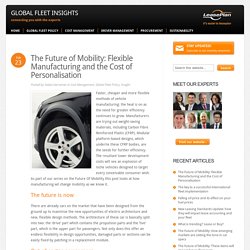
Manufacturers are trying out weight-saving materials, including Carbon Fibre Reinforced Plastic (CFRP). IoT-Enabled Mobility – The Future of Field Service Management. With the number of connected devices expected to rise from 10 billions today, to 50 billion by 2020, The Field Service Management (FSM) Industry has reached a crucial crossroads.
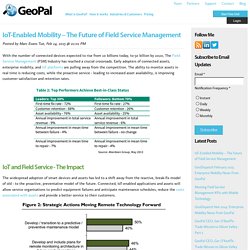
Early adopters of connected assets, enterprise mobility, and IoT platforms are pulling away from the competition. The ability to monitor assets in real time is reducing costs, while the proactive service - leading to increased asset availability, is improving customer satisfaction and retention rates. Shared-Use Mobility: What Does the Future Hold? Workshop Synopsis.
This workshop was sponsored by the Emerging and Innovative Public Transport and Technologies Committee (AP020); Shared-Use Mobility and Public Transit Subcommittee (AP020(1)); Emerging Ridesharing Solutions Joint Subcommittee (AP020(2)); Automated Transit Systems (AP040) Committee of the Transportation Research Board of the National Academies —Prepared by Susan Shaheen, PhD and Matthew Christensen, Transportation Sustainability Research Center, University of California, Berkeley On Sunday, January 11, 2015, Professor Susan Shaheen from the University of California, Berkeley and Jeffrey Chernick from RideAmigos led a one-day workshop on the present and future of shared-use mobility at the Transportation Research Board annual meeting in Washington, DC.
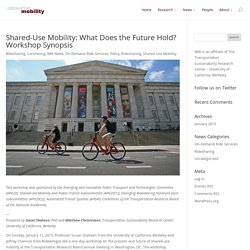
Will technology help us escape urban commuting hell? Welcome to Forbes. The Future Of On-Demand Drivers: 'Hyper-Efficient Logistics Experts' Drones for Good. What Kids Think The Car Of The Future Should Look Like Is Awesome. And MINI Frontiers exhibition: the future of mobility. Dezeen and MINI Frontiers exhibition: the future of mobility Dezeen and MINI Frontiers: six cutting-edge young designers will present radical visions for the future of mobility at a major exhibition during London Design Festival this September (+ movie).
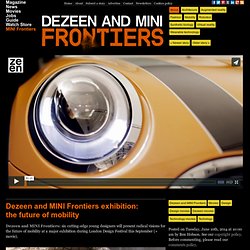
From cars made out of living materials to preparing the human body for space travel, the exhibition at designjunction will explore a range of innovative concepts about how design and technology could transform the way we travel. "The Dezeen and MINI Frontiers exhibition will showcase radical ideas for how we might get around in future," says Dezeen editor-in-chief Marcus Fairs in the introductory movie above.
Alexandra Daisy Ginsberg is collaborating with scientists and engineers working in the emerging field of synthetic biology to investigate genetically engineered cars grown from living materials. See past projects by Ginsberg we've featured on Dezeen » 5 Crucial Principles for 21st Century Transportation Systems. Over the rest of the 21st century, cities will face many forces far beyond their control: mega-trends such as dramatic shifts in population, the financial vulnerability of a globally connected economy, resource scarcity, rising income inequality, and an increase in the droughts, floods, heat waves, cold waves, sea level rise, and storm surges caused by climate change.
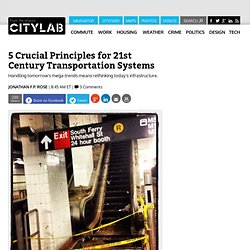
Preparing for all these stresses won't be easy, but a critical place to start is with urban infrastructure — an area where many U.S. cities are most vulnerable. Infrastructure is the platform of the common good. It connects us in nested networks of systems, integrating homes, neighborhoods, cities, regions, and nations. Cities thrive with internal and external connectedness, and the backbone of this connectivity are our urban transportation systems. Drone dispatchers and amnesia surgeons: A sneak peak into the jobs of the future. IDEO Imagines the Wild Future of Self-Driving Cars. IDEO came up with three future concepts for self-driving cars.
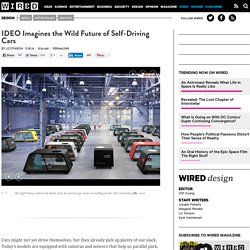
This is your personal vehicle, which you drive daily. Once the car is driving autonomously, you can swivel around to get some work done at your interactive console. IDEO This is your personal vehicle, which you drive daily. A Bot in Every Garage and on Every Street. Here's an idea on how fast bots are going to roll out and why botageddon in some form is inevitable.
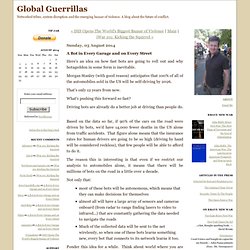
Morgan Stanley (with good reason) anticipates that 100% of all of the automobiles sold in the US will be self-driving by 2026. That's only 12 years from now. What's pushing this forward so fast? Link Urban Logistics System Utilizes Existing Public Transportation Infrastructure to Navigate The City. Distribution of goods can be a challenge in urban environment, especially when today’s logistics are unorganized and unsynchronized.
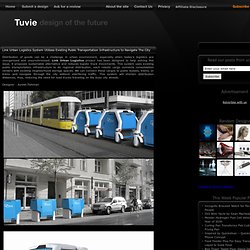
Link Urban Logistics project has been designed to help solving this issue, it proposes sustainable alternative and reduces logistic truck movements. This system uses existing public transportation infrastructure to do regional distribution, each robotic cargo connects consolidation centers with existing neighborhood storage spaces. Smartphones and the Uncertain Future of 'Spatial Thinking' Like most New Yorkers, I spend an inordinate amount of time in transit.
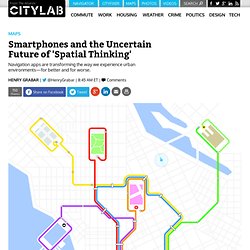
I have an unlimited Metrocard and a Citi Bike key, two bicycles and a motorcycle, and a dozen pairs of shoes. Proper wayfinding is my lifelong neurosis, as if a personal score could be tallied from the 10,000 rounds of Navigation I've played against the city. But I've lately undergone a crisis of confidence: I find it hard to hit the road without consulting my phone. The Platform for Unmanned Cargo Aircraft (PUCA) - Platform Unmanned Cargo Aircraft. The 4 Transportation Systems You'll Meet in the Future. Redesigning The Office — David McKinney. I received a heap of questions after this post.

Here are some answers to the most common questions. How do you get power? I have two batteries in the van: a 12v “Start” battery which starts the engine, and a 12v “House” battery which runs everything else. The House battery is connected to an inverter which converts 12v DC to 240v AC (I’m in Australia). "Operating system for urban mobility" wins Audi Urban Future award. News: a team from Mexico City has won this year's Audi Urban Future award with a scheme that collects location data from commuters to identify problems in the city's congested road network (+ slideshow).
The interdisciplinary team, headed by architect and city planner Jose Castillo, proposed an "operating system for urban mobility" to relieve the Mexican capital of its problems with traffic – beating groups from Berlin, Seoul and Boston to win the €100,000 (£80,000) prize awarded by German car brand Audi. An estimated four million vehicles use Mexico City's road network, with the worst affected areas around the Santa Fe business district – where commuters face journeys of up to three hours to reach their workplaces. Hundreds of Buses and Taxis in Portugal Form a Mesh Wi-Fi Network.
A massive mobile Wi-Fi network that could be a model for many cities was launched in the city of Porto, Portugal, this fall. Buses and taxis are equipped with routers that serve as mobile Wi-Fi hot spots for tens of thousands of riders.